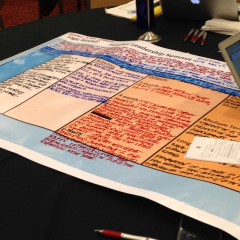This weekend in SeaTac, educators from nearly twenty states assembled for the Washington Teach To Lead Summit. Teams brought leadership ideas in various stages of incubation, and staff from ED facilitated a guided thinking and planning process to help take abstraction and organize it into more refined, defined, actionable planning.
One thing became clear very quickly: teacher leadership is messy, complicated work that often is the hidden engine driving meaningful change.
My role here has been to be a presenter and a “critical friend” for a team to assist in their thinking and project development. I had the incredible privilege of working with a team from here in Washington state as they tackle a unique but important struggle around which they want to leverage teacher leadership.
The kids and community around Marysville, Washington suffered tremendous trauma with the violence of almost a year ago. One school in particular realized that traumas such as this, as well as the often hidden and cyclical traumas that often occur in children’s lives, have a direct impact on students’ ability to succeed in school. A team from Quil Ceda Tulalip Elementary came to the Teach to Lead Summit to help refine their project, which aims to proactively equip these young students with knowledge, skills, and strategies to handle the complex emotions that come with traumas, whether connected to the recent shared community trauma or the private struggles that happen at home. These educators know that test scores, too often The Measure of school effectiveness, only tell a tiny chapter of the story: these educators know that in order for academic achievement data to show growth, a child needs to be in the physical and emotional place to even learn in the first place.
Their project is so ambitious and humongous, and the messy work of the first day of the Teach to Lead Summit included the process nearly all of the teams experienced: the work would balloon to tremendous proportions, then contract again…then balloon in another way, and then contract again. At one point, staff from US ED were even talking about connecting the team with staff at the White House, given President Obama’s developing awareness about Native populations in our country (Quil Ceda Tulalip serves Native students as a dominant proportion of the student body). That scope would later contract to a minute grain-size of conversation to discrete moves a certain teacher in the building has employed to support students. After much collaboration, research and conversation, the team narrowed its focus to an action plan centered on equipping teachers with the pedagogical and classroom strategies to then help kids learn the self-management skills that will enable them to access the learning more readily by calming the turmoil that may be happening in their minds. In addition to supporting teachers toward better supporting students, the team plans to tackle the task of informing district leadership about exactly how and why attending to the social and emotional well-being of a child actually has a direct and significant impact on the “data” that matters so much at the top of the hierarchy.
The Teach to Lead Summit was filled with other teams wrestling with the same challenges as the team from Quil Ceda Tulalip. The Quil Ceda Tulalip team’s process, tackling this incredibly important work, is part of the challenge of teacher leadership in the broader sense. There are not usually existing systems or even other examples for what teacher leaders want to do. Protocol, policy, and procedure are often very concise, linear and concrete: leadership and leadership development is not. Protocol and policy are often about cold compliance; leadership is about ideas and people. At the core of authentic leadership development, often, is an outcome that is not so concrete as test scores, nor nearly as measurable… but I’d argue, more important because it represents the hidden work that makes those concrete indicators possible, like the engine hiding under the hood.
Teacher leadership is so frequently a hidden force for change, just as the team from Quil Ceda Tulalip realizes that there are hidden forces that impact a student’s school experience. Because the work is often invisible, and often driven by innovative, pioneering teacher-leaders operating with no instruction manual, it can sometimes be hard to explain to others…or even to ourselves.
And that is what makes the work so critical to do: it is about entering new territory and charting a new future for what schools look like in the United States. The heartening thing is that through experiences like this Teach to Lead Summit, teachers are gaining the skills, knowledge, and confidence to give voice and action to the work that needs to be done.

Hidden masters of change. Christy Anana has been a quiet, consistent wave at QuilCeda Tulslip effecting powerful systemic change. It is humble leadership that is making a powerful difference!
One of the Quil Ceda Tulalip team members, Christy Anana, has published some work related to this project…worhty of a look if you or your school are facing similar struggles: http://www.amazon.com/Can-Feel-Better-Tapping-Healing/dp/145753472X/ref=la_B00TYO9USQ_1_1/190-6249356-4321447?s=books&ie=UTF8&qid=1443368892&sr=1-1